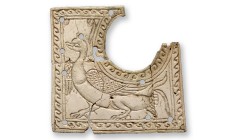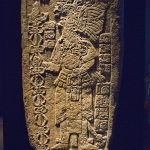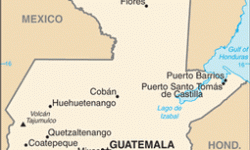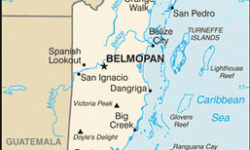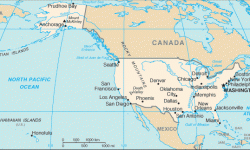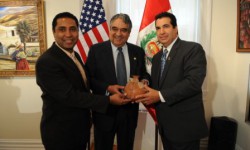Naranjo Stela 30
Author: Donna Yates
Last Modified: 11 Sep 2023
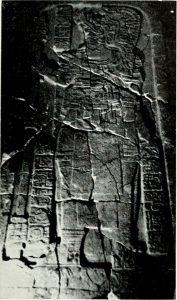
Stolen Maya sculpture seized by US Authorities when a crate carrying it broke open in the port of Houston
Naranjo is a Maya site located near Guatemala’s border with Belize. It is 18 km north of the town of Melchor de Mencos via a logging road built in the 1950s (Peabody Museum n.d.). Naranjo was discovered in 1905 by Teobert Maler, who recorded 32 stela at the site, including Naranjo Stela 30 (Maler 1908). The front of the stela depicts a standing male figure holding a staff with inscriptions around him. The back of the stela displays a lengthy inscription. The stela was the “second from the right-hand (southern) end in the front row of four stelae on the terrace at the foot of Structure C-9 ( Peabody Museum, n.d.) The stela is 2.33 meters tall (Peabody Museum, n.d.)
The man depicted on Naranjo Stela 30 is K’ak Tiliw Chan Chaak who ruled Naranjo from 31 May 693 until around 728, the year he died. K’ak Tiliw Chan Chaak has been the subject of much research and speculation about Maya politics and rulership. He is the son of “Lady Six Sky” (the pronunciation of her real name is as yet unclear), an elite woman from the site of Dos Pilas, who served as regent of Naranjo during K’ak Tiliw Chan Chaak’s childhood. After K’ak Tiliw Chan Chaak ascended to rulership, Lady Six Sky curiously continued to erect stela that indicated that she was the ruler of Naranjo. She also outlived her son. K’ak Tiliw Chan Chaak’s father was not the ruler of the site and appears to have been relatively insignificant: power was held by mother and son.
“Serious plunder” is thought to have begun at Naranjo in 1964 resulting in considerable loss and damage to the site’s monuments, and various looting groups using different techniques raided the site in subsequent years (Peabody Museum n.d.). The exact date of the looting of Naranjo Stela 30 is unknown, but Ian Graham believed it took place around 1966 (Peabody Museum, n.d.). The stela was broken into smaller pieces for transport. Specifically, the front of the stela was “crisscrossed” with careful breaks which allowed for retention of details of the sculpture. The back, being less marketable, was smashed and “lies in a thousand chips at the site” (Peabody Museum, n.d.)
On 27 January 1967, the stolen front of Stela 30 was detected by the U.S. Customs Service in Houston Texas in a crate marked “Machinery” (Peabody Museum, n.d.). The stela had been broken into 32 pieces and had been shipped from Belize City to New Orleans (UPI 1971) and then on to art dealers in Houston (Corpus Christi Times, 1969; UPI 1971). The crate reportedly “Broke open on a Port of Houston loading dock” (UPI 1971) alerting authorities to its presence.
In December 1970 U.S. District Judge James Noel ordered that Stela 30 be returned to Guatemala (Corpus Christie Times, 1970; UPI 1971), however the judge ruled that Guatemala had to pay $1400 in storage fees to the warehouse where the piece was kept for three years to reclaim the Stela (Corpus Christie Times, 1970).
The Stela is now in the Museum Nacional in Guatemala City (Robertson 1972).
[IMAGE: Naranjo Stela 30 in pieces in 1971, photographed by Joya Haii, via Bulletin (Field Museum of Natural History), see: https://archive.org/details/bulletin43fiel/mode/1up?view=theater]
Works Cited
Coggins, Clemency C. (1969) Illicit Traffic of Pre-Columbian Antiquities. Art Journal 29(1): 94, 96, 98, 114. https://www-jstor-org.mu.idm.oclc.org/stable/775285. Accessed on 28 August 2023.
Corpus Christi Times (1969) Judge Asked to Order Art’s Return. The Corpus Christi Times, 21 January.
Corpus Christi Times (1970) Way Paved for Return of Artifact. 31 December.
Maler, Teobert (1908) Explorations in the Department of Peten, Guatemala, and Adjacent Region. Memoirs of the Peabody Museum, Harvard University, 4(2).
Peabody Museum of Archaeology & Ethnology (n.d.) Naranjo. Corpus of Maya Hieroglyphic Inscriptions. https://peabody.harvard.edu/naranjo. Accessed on 6 August 2023.
Roberson, Merle Greene (1972) Monument Thievery in Mesoamerica. American Antiquity. 37(2): 147–155.
Reinhold, Robert(1973) Scholars of Maya in a Race with Art Thieves and Time. 26 March. https://www.nytimes.com/1973/03/26/archives/article-2-no-title-scholars-of-maya-in-a-race-with-art-thieves-and.html. Accessed on 28 August 2023.
UPI (1971) Old Carving Will Go Back to Guatemala. Amarillo Daily News. 1 January 1971.
